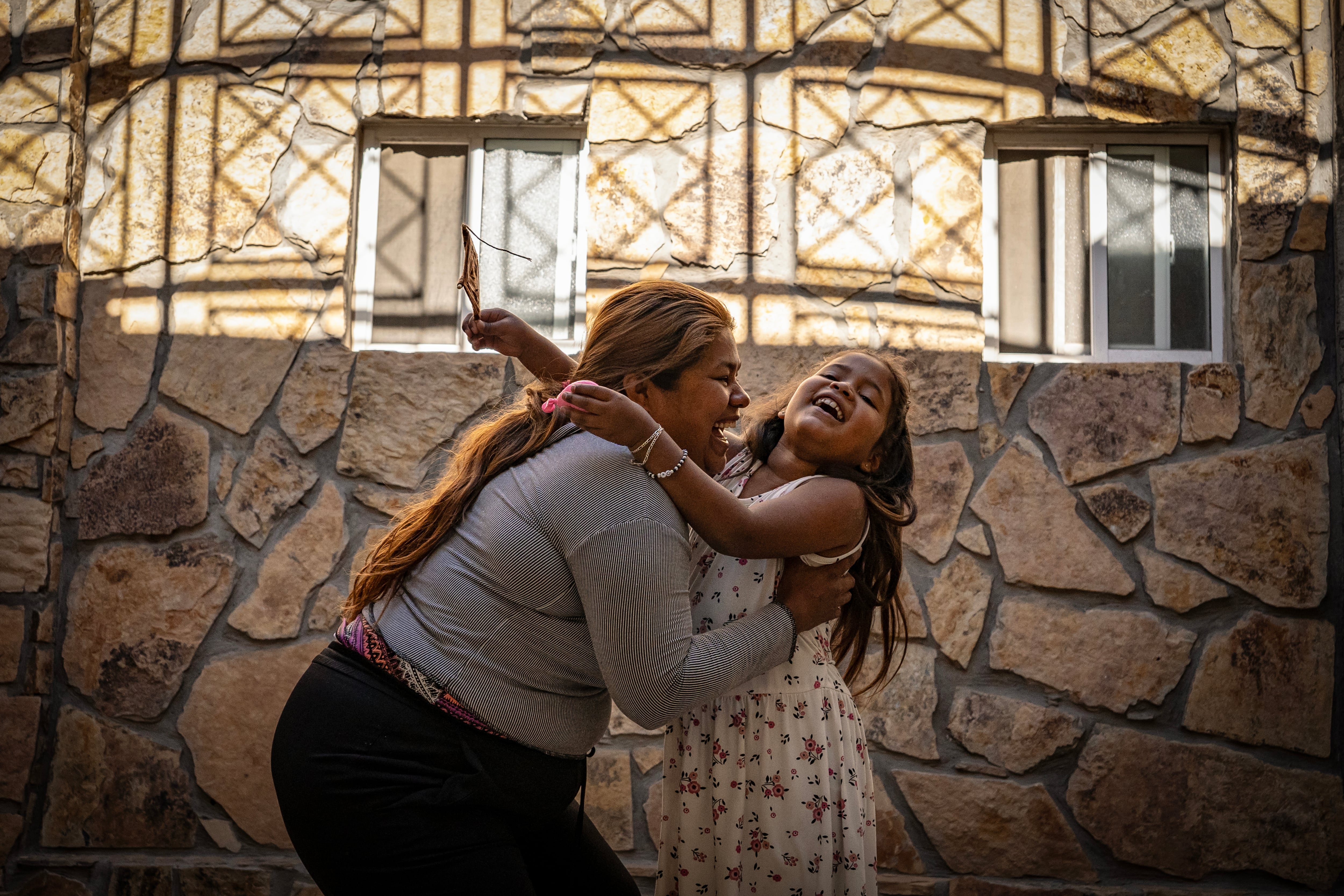
For the thousands of migrants waiting in Mexico for the CBP One application to give them an appointment to request a humanitarian permit to enter the United States, getting one is more urgent than ever now that Donald Trump has won the election on a pledge to end this program and carry out mass deportations. The Joe Biden administration, which launched this free tool almost two years ago to regulate the flow of people who arrive at the border to request asylum, says that most app users get an appointment in less than eight weeks. But many of those waiting in Ciudad Juárez say they have been waiting for months without any luck in what they consider a lottery; a raffle that has now become a race against time with the finish line on January 20, the day the Republican will take office.“I have been waiting in Mexico for a year for my appointment with CBP One,” says Damarys Godoy, a Venezuelan migrant who participates every Thursday in an embroidery workshop in the Ciudad Juárez cathedral, while her eight-year-old daughter Carlys does crafts with a group of migrant children. This 34-year-old woman decided to leave Colombia — where she had migrated in 2016, driven by the Venezuelan crisis — with her husband and the youngest of her three daughters, encouraged by a sister who lives in Miami. Now, after crossing the dangerous Darién jungle and spending 12 months in Mexico, she lives with the uncertainty of whether they will be able to cross the border before Trump arrives at the White House. “We want to enter legally to give our children a future, but we are afraid because he says he doesn’t like migrants and even less us Venezuelans, because some have done bad things,” she says.Migrants like her are waiting in fear not only because of Donald Trump’s promises to end CBP One and other humanitarian programs, which have benefited 1.3 million people, or to launch mass deportations, but also because of memories of the first term of a president who has won two elections with an anti-immigrant rhetoric, and who used cruelty as a deterrent with policies that separated thousands of children from their undocumented parents at the border. Six years later, hundreds of these families have still not been reunited because the government lost track of the parents after deporting them, and it is increasingly difficult to imagine that they will ever be able to do so.Migrants receive food at the Cathedral of Ciudad Juarez, on November 21, 2024.Nayeli CruzThat is why Damarys dreams of getting an appointment before January to legally cross the border and apply for a work permit. “If not, we will be very worried because we do not know what will happen to us if the United States immigration authorities catch us. What will happen to my little girl?” she asks. “They can take her away from us because I heard that Trump did that in the past.” While migrants speculate about what will happen once the Republican returns to the White House, the organizations that assist them are trying to join forces against the promise of mass deportations, but also in the face of a possible increase in the flow of people before January 20 or the implementation of new restrictions that could bring a new crisis to the border.A laboratory for “externalizing borders”“We are aware that this is going to be a difficult time. At the border we are used to living in this emergency situation, especially in the last five years,” acknowledges Blanca Navarrete, director of the organization Derechos Humanos Integrales en Acción (DHIA). This 43-year-old woman who has spent more than half her life dedicated to migrants in Ciudad Juárez recounts the episodes that have overwhelmed the capacity of this town separated from the Texan city of El Paso by the Rio Grande and an ever-growing wall with barbed wire.First, Navarrete recalls, there were the migrant caravans that brought together thousands of people seeking protection on their way north. Then came the Migrant Protection Protocols, under which Trump sent more than 71,000 people to Mexico to wait their turn to request asylum, and under which huge refugee camps were formed on the border line. With the Covid pandemic came Title 42, under which the Republican president closed the border invoking public health reasons. And they also had to deal with thousands of confused migrants that Washington sent on the so-called “lateral flights,” where migrants who entered the United States illegally are sent back to Mexico through other points along the border.Women cross the Paso del Norte International Bridge from Ciudad Juarez, into El Paso, Texas, on November 22, 2024.Nayeli CruzFor Dirvin Luis García Gutiérrez, head of the Migrant Assistance Program division of the Juárez State Population Council (Conapo), Trump’s presidency was a kind of test laboratory for “externalizing borders” to other countries, which the cities of northern Mexico took on as best they could. “The return of foreigners to national territory from the United States is something that had never been seen before and that had never been agreed upon or implemented,” says the Chihuahua State official. For him, the most shocking thing was when they began to receive between 200 and 300 migrants a day through lateral flights: processing so many bewildered, traumatized and sometimes sick migrants exceeded the city’s capacity. “That was a real humanitarian crisis. I think it’s the closest thing I’ve seen to what could be compared to a war,” he recalls.But the Trump presidency also left positive things at the border, adds Blanca Navarrete, such as the support of activists, religious groups, human rights defenders and international organizations that came to support them. “I remember the helplessness because we had never been so close to the limit, but at the same time I also remember a lot of solidarity from the people who went to the Santa Fe international bridge with meals for those who were waiting to enter to request asylum,” she points out. “Although unfortunately that solidarity later began to wear away, because Trump’s hate speech finally managed to permeate the narrative.”“The outlook is complicated because we have noticed that there are now even obstacles to regularizing one’s status in Mexico,” admits her work partner Ciela Ávila, a 27-year-old daughter of a migrant from Oaxaca who arrived in Ciudad Juárez decades ago with the intention of crossing into the United States but ended up staying in the border city. “At least from my perspective, the only hope I see is that the people who are working on the issue will not run out of energy.”Blanca Navarrete, Gabriela Romero, Ciela Ávila and Diana Solís, in Ciudad Juárez, on November 21, 2024.Nayeli CruzA new emergency?Now these organizations feel that they are experiencing the calm before the storm. Shelters in the State of Chihuahua are at just over 50% occupancy, according to Conapo data, and there has also been a reduction in illegal crossings to the lowest level since 2020, which the organizations attribute in part to the implementation of the CBP One application, but also to the greater control of the Mexican authorities to prevent migrants from approaching the northern border and distributing them throughout the southern states. However, in recent times they have also identified an increase in kidnappings, both at the entrance from Durango to Chihuahua and at different points in Ciudad Juárez, where they have held more than 100 foreigners in the so-called “safe houses,” a sign that “organized crime already has control of this human smuggling business,” explains Diana Solís, from DHIA. There has also been a spike in deaths in remote desert areas where migrants are likely being pushed to escape the violence and the increased border enforcement.Almost two months before Trump returns to the White House, Juarez is preparing to deal with a possible new emergency at the border. And although people here do not believe in the feasibility of the Republican’s promise to deport the more than 11 million undocumented immigrants estimated to be living in the United States, everyone is aware that the city is not ready for events like those it experienced in the past. “No shelter is prepared to receive a big wave of people,” says Pastor Juan Fierro, director of El Buen Samaritano. “If they plan to deport everyone through the northern border of Mexico, it will be a problem for us in the sense that we do not have the capacity to deal with it. It will cause chaos because they will be living under bridges, in abandoned farms where they can take cover because of the cold weather, and the National Institute of Migration will begin to deport them as well,” he says.In their shelter, which has a capacity for up to 180 people, they have had up to 250 residents at a time. Now there are only 42, most of them families of Venezuelan migrants, like Bárbara Mendoza, her husband and their children Matías, eight, and Zahira, who was born on the road to Juárez, in Durango, 19 days ago; there are Central Americans like Fidela Baldano, who fled Honduras 14 months ago with her two daughters, ages six and 16, after gangs killed one of her sons and tried to recruit another; and Mexicans displaced by violence like Itzel, from Iguala (Guerrero), who also migrated with her two children following in the footsteps of her husband, who crossed into the United States after receiving threats from organized crime. “He told us to make an appointment, that they are going to cancel [the program] and then what are we going to do,” says this woman who, like the rest of the migrants at the shelter, hopes to get an appointment to enter the U.S. with CBP One. “If they cancel the program, we don’t know what to do. Only God knows.”Barbara Mendoza and her son Matias at a shelter in Ciudad Juarez, on November 21, 2024.Nayeli CruzSign up for our weekly newsletter to get more English-language news coverage from EL PAÍS USA Edition

US border braces for four years of cruelty: ‘If they catch us, what will happen to my little girl?’ | U.S.
Tiempo de Lectura: 6 Minutos
What’s your Reaction?
0%
Love
0%
Smile
0%
Haha
0%
Sad
0%
Star
0%
Weary
Shares:







